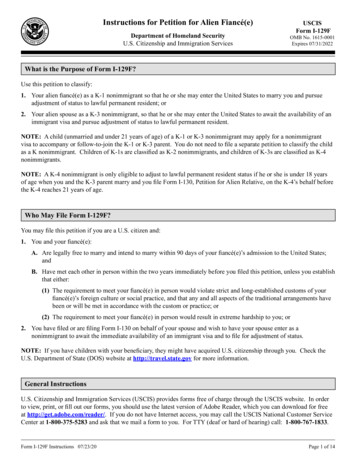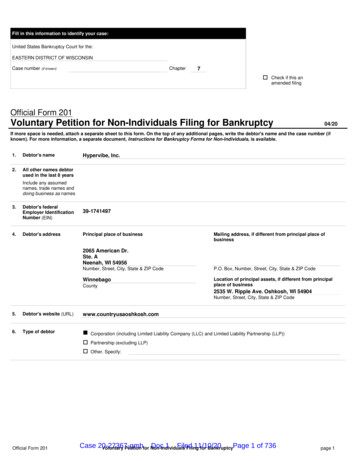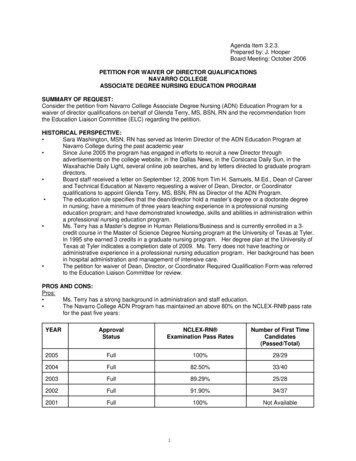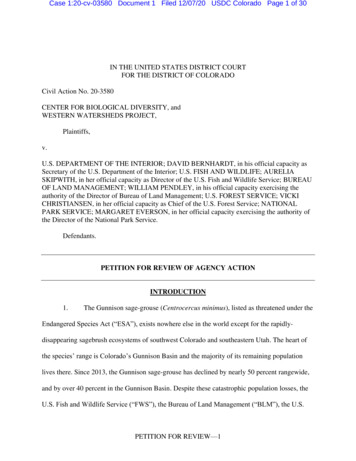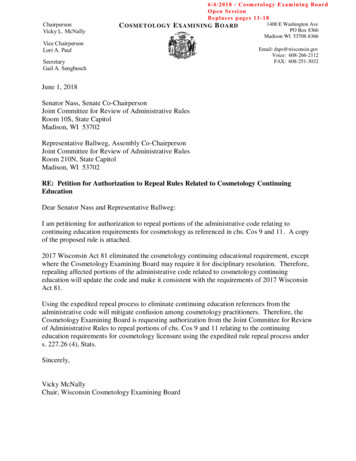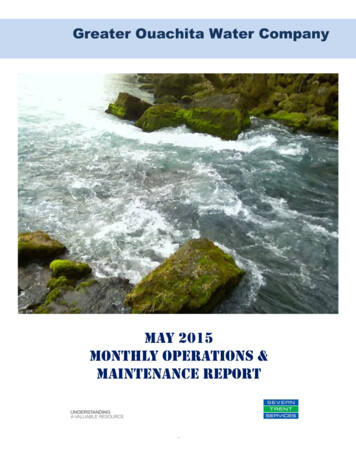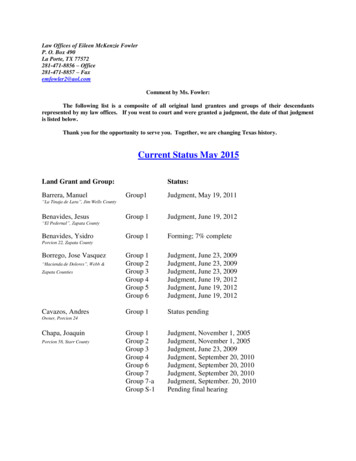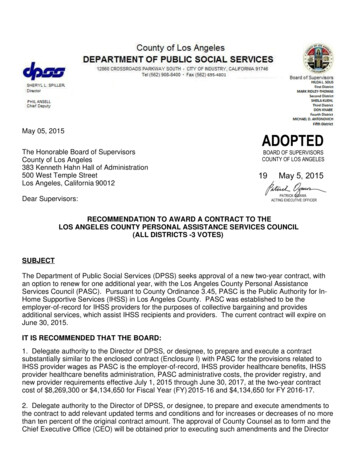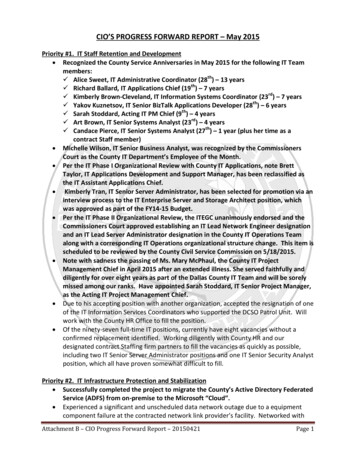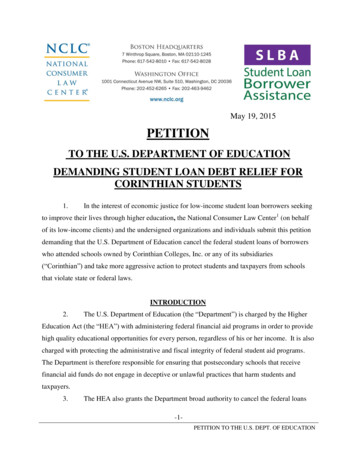
Transcription
May 19, 2015PETITIONTO THE U.S. DEPARTMENT OF EDUCATIONDEMANDING STUDENT LOAN DEBT RELIEF FORCORINTHIAN STUDENTS1.In the interest of economic justice for low-income student loan borrowers seekingto improve their lives through higher education, the National Consumer Law Center1 (on behalfof its low-income clients) and the undersigned organizations and individuals submit this petitiondemanding that the U.S. Department of Education cancel the federal student loans of borrowerswho attended schools owned by Corinthian Colleges, Inc. or any of its subsidiaries(“Corinthian”) and take more aggressive action to protect students and taxpayers from schoolsthat violate state or federal laws.INTRODUCTION2.The U.S. Department of Education (the “Department”) is charged by the HigherEducation Act (the “HEA”) with administering federal financial aid programs in order to providehigh quality educational opportunities for every person, regardless of his or her income. It is alsocharged with protecting the administrative and fiscal integrity of federal student aid programs.The Department is therefore responsible for ensuring that postsecondary schools that receivefinancial aid funds do not engage in deceptive or unlawful practices that harm students andtaxpayers.3.The HEA also grants the Department broad authority to cancel the federal loans-1PETITION TO THE U.S. DEPT. OF EDUCATION
of students harmed by postsecondary schools that engage in deceptive or unlawful practices andto seek reimbursement from schools for the cancelled loans they fraudulently obtained. TheDepartment is therefore also responsible for granting a fresh educational start to students who,through no fault of their own, are deceptively lured into enrolling at schools that do not provide ahigh quality education as envisioned by the HEA. In addition, it is responsible for ensuring thatschools return to taxpayers any funds obtained through illegal practices.4.Evidence from multiple government actions and investigations, dating from asearly as 2007, along with Corinthian’s rapid growth and poor student outcomes, provided strongwarnings that Corinthian’s nationwide marketing and education system was likely permeatedwith deceptive and unfair business practices that violated multiple state and federal laws.5.Despite these warnings, the Department did not restrict or revoke Corinthian’seligibility for government financial aid until June 2014. By failing to act, the Departmentfostered Corinthian’s ability to turn taxpayer-funded financial aid into billions in profits for itsshareholders. It also facilitated Corinthian’s sophisticated and deceptive scheme to bilkhundreds of thousands of low-income students of their dreams, and leave them and taxpayers tofoot the bill.6.Despite the Department’s culpability for the harms caused to Corinthian students,it has failed to use its statutory authority to provide widespread debt relief through loancancellations. While the Department has let Corinthian off the hook for the billions that it shouldrefund to both students and taxpayers, it continues to pursue Corinthian students mercilessly forloan repayment. The Department is unjustly shifting the financial harm caused by its mistakesonto the backs of Corinthian students who can least afford to pay for the Department’s neglect,who are not at fault, and who were deceived into taking out federal loans based on Corinthian’sfalse promises.7.In doing so, the Department has seriously undermined the purpose of the HEA.Instead of equal access to quality education for Corinthian’s low-income students, the majorityof whom are women and people of color,2 the Department’s actions have left them withworthless credentials, mountains of defaulted student debt, and despair at ever being able toprovide better lives for their families. At the same time, by bailing Corinthian out of its financialmess and releasing its right to pursue the Corinthian schools sold to Education Credit-2PETITION TO THE U.S. DEPT. OF EDUCATION
Management Corp. for the repayment of billions in losses to taxpayers, the Department hascreated an expectation that it will do the same for other for-profit postsecondary schools thatengage in illegal or deceptive practices.8.The Department has prioritized the collection of student loans over treatingCorinthian students justly and fairly. It has prioritized generating revenues for the federalgovernment over its Congressional mandate to provide equal access to quality education for lowincome students and to help students start over, free of debilitating student debt, when they havebeen harmed by fraudulent schools.FACTS THE DEPARTMENT KNEW OR SHOULD HAVE KNOWNA.Corinthian’s Single-Minded Focus on Growing Profits, to the Detriment ofEducational Quality, Led to Poor Student Outcomes9.Founded in 1995, Corinthian is engaged in the business of operating post-secondary schools for a profit. Corinthian owns multiple corporate subsidiaries that operate thefollowing brands: Everest Institute, Everest College, Everest University Online, Everest CollegePhoenix Online, Heald College, and WyoTech.10.Corinthian’s rapid expansion, combined with financial aid revenues near the 90%limit allowed by federal law, high withdrawal rates, high cohort default rates, astronomicalprofits, and high expenditures on recruiting and marketing should have alerted the Departmentthat Corinthian did not provide quality education, that its students were not able to find jobs thatallowed them to repay their debts, and that Corinthian was likely engaging in deceptive practices.11.Almost all of Corinthian’s profits came from federal financial aid revenues. TheHEA allows for-profit schools to earn up to 90% of their revenues from Department ofEducation financial aid programs. The availability of so much guaranteed revenue fueledCorinthian’s rapid growth beginning in 1999, when Corinthian became a publicly tradedcompany. Enrollment increased from 15,900 students in 1999 to 113,818 students in June 2010,an increase of 615%.3 Between 1999 and 2012, the company grew from 35 colleges in 15 statesto 105 colleges in 25 states, along with two schools that offer distance education programs.412.As a result, Corinthian’s unrelenting focus on generating profits paid off. Itsprofits grew from 21 million to 240.8 million between 2007 and 2010, an astronomical eleven-3PETITION TO THE U.S. DEPT. OF EDUCATION
fold increase in just three years.5 Rather than investing these profits in quality education andservices, Corinthian diverted a large portion to marketing and recruiting expenditures, executivesalaries, and payments to shareholders.613.From 2000 to 2010, Corinthian’s net revenue increased over 900%, from 171million to 1.76 billion.7 This revenue growth resulted from Corinthian’s targeting of lowincome students who were eligible for federal funds in the form of grants and loans. In 2012,Corinthian reported that approximately 85% of its students had family incomes of less than 45,000.8 A 2011 survey indicated that over 57% of Corinthian students had a household incomeof 19,000 or less, and 35% of its students had a household income of less than 10,000.914.Due to its focus on low-income students, Corinthian consistently received over80% of its revenues from Department financial aid funds. In 2010, for example, 89.8% ofCorinthian’s revenues came from Department financial aid.10 From 2007 to 2010, Corinthian’sreceipt of Pell Grants tripled from 170.2 million to 509.3 million.11 Over 96% of students atfor-profit colleges like Corinthian obtain federal student loans.1215.The revenue growth also resulted from Corinthian’s high tuition, which wasamong the highest of the for-profit schools examined by the U.S. Senate Health, Education,Labor and Pensions Committee (the “Senate HELP Committee”) in 2012.13 According to theSenate Help Committee, for example, a Medical Assistant diploma from Heald College inFresno, California, cost 22,275, compared to 1,650 at Fresno City College. At Everest Collegein Ontario, California, an Associate Degree in Paralegal Studies cost 41,149, compared to 2,392 at Santa Ana College.1416.One would expect corresponding success from Corinthian’s students. ButCorinthian has consistently produced poor student outcomes. Over 50.5% of the students whoenrolled at Corinthian in 2008-9, for example, withdrew by mid-2010.15 For these students, themedian withdrawal period was just over 3 months.1617.Corinthian’s graduates have had little success finding employment in the fieldsfor which they were trained, or in finding employment that pays enough to allow them to repaytheir hefty student loans (see Section B, below). As a result, Corinthian’s students have defaultedon both their private and federal student loans at high rates. Corinthian’s three-year cohortdefault rates, which reflect the percentage of students who default within three years of entering-4PETITION TO THE U.S. DEPT. OF EDUCATION
repayment, grew from 22.9% for students entering repayment in 2005 to 36.1% of students whowere entering repayment in 2008.17 This was the highest default rate of any publicly tradedcompany examined by the Senate HELP Committee in 2012.1818.Tuition was so high that students often had to take out expensive private loansoffered by Corinthian. These private loans have defaulted at extremely high rates. Corinthianestimated student default rates exceeding 50% for its private loan programs.19B.Corinthian Engaged in Widespread Deceptive Practices to Conceal Poor StudentOutcomes, Increase Student Enrollments, and Maintain Federal Financial AidEligibility19.Based on evidence, accreditor audits, and government actions and investigationsdating from as early as 2007 (see Exhibit A for a summary), the Department knew or shouldhave known that Corinthian was likely engaging in widespread deceptive practices that violatedboth state and federal laws, harmed thousands of Corinthian students, and would eventually leadto its financial collapse. While some of these government actions are still pending, theaccumulating actions and evidence obtained pursuant to government and accreditorinvestigations were strong indicators that Corinthian’s nationwide marketing and educationsystem, from a student’s first exposure to the last day of his or her attendance, was suffused withillegal, deceptive and unfair business practices.20.The allegations in this Petition are based on allegations, findings, and/or evidencefrom the accreditor audits, media investigations, and government actions and investigationslisted in Exhibit A. Corinthian operated a system-wide recruiting machine designed todeliberately mislead prospective students and increase enrollments, with the goal of generatingincreasing profits for shareholders.21.Corinthian required recruiters to make hundreds of calls a week to prospectivestudents, referred to as “leads.” Its recruiters often called individuals multiple times a day andrefused to provide information by phone, such as tuition costs and placement rates. Instead,recruiters pushed students to visit campuses where Corinthian could apply maximum pressure toinduce them to enroll.22.Corinthian placed intense pressure on recruiters and those who supervised them to-5PETITION TO THE U.S. DEPT. OF EDUCATION
enroll large numbers of students. Corinthian set enrollment goals for campuses and recruiters,and recruiters who failed to achieve their goals were in jeopardy of losing their jobs. Oncestudents visited a campus, they met with recruiters who were encouraged to identify and useprospective students’ pain and vulnerability to pressure them to enroll. Recruiters were told toprevent students from leaving without enrolling and often misrepresented the urgency by statingstudents would lose their seats if they did not enroll immediately. Faced with this sophisticatedrecruiting system, prospective students who had misgivings about enrolling had little chance ofmaking a decision not to enroll.23.At each step of its enrollment process, Corinthian strategically made deceptive orfalse representations that were material to students’ decisions to enroll. It preyed on the desiresof students to find higher paying employment to provide better lives for themselves and theirfamilies. Corinthian knew that “[e]nrollment largely hinges on selling affordability and [job]placement.”20 Through advertisements, recruiter statements, and disclosures, Corinthianrepresented that it offered high quality education that led to high percentages of its graduatesobtaining high paying employment in the fields they studied. It represented that it would placestudents in externships that would provide further training. It also represented that it provided alifetime of post-graduate job placement assistance.24.In reality, Corinthian’s substandard training did not prepare students foremployment. Corinthian employed unqualified instructors and often provided insufficient or outof-date instructional equipment. Many students had to find externships on their own, while theCorinthian-provided externships often gave little or no training in the students’ fields of study.Corinthian provided meager or no job placement assistance. Moreover, Corinthian graduatesfound employment in the fields trained for in lower percentages and at lower wages thanrecruiters orally represented.25.Recruiters even enrolled students who they knew would not be able to findemployment in the field for which the students trained because they lacked English languagecapability, had a criminal history, or had not completed high school or passed an exam ensuringthat they would understand and benefit from their education.26.The following allegations and/or findings from a variety of sources, includinggovernment complaints, settlements, and investigations, media investigations, and accreditor-6PETITION TO THE U.S. DEPT. OF EDUCATION
audits, suggest that Corinthian, at campuses throughout the country, deliberately falsified andinflated the placement rates that it provided to accreditors to maintain its financial aid eligibilityand to prospective students to induce them to enroll.a.In 2007, the California Attorney General obtained a consent order againstCorinthian based on evidence that it had inflated the placement rates for every programinvestigated by the California Attorney General by as much as 37%21 and had likelymisled California students enrolling on or after January 1, 2003.22b.In October 2010, Corinthian admitted that it had fabricated employmentrecords of 288 graduates of Everest College in Arlington, Texas, over a period of 4years.23c.In April 2011, the Department’s own Inspector General issued a subpoenaregarding placement rates at the Everest Institute campus in Jonesboro, Georgia.24d.In July 2011, the Massachusetts Attorney General filed suit againstCorinthian, alleging that it had inflated placements rates in some of the programs offeredby Everest Institute’s Massachusetts campuses by as much as 49%.25e.In December 2011, the Accrediting Commission of Career Schools andColleges (ACCSC) notified Corinthian that 39 of 167 medical assistant graduates fromEverest College in Hayward, California, were recorded as being employed by the sameagency. Each graduate had only been employed for 2 days.26f.In March 2012, a Corinthian audit of placement files from Everest CollegeSan Francisco showed that 53% were missing employment verification forms.27g.In August 2012, an ACCSC third-party audit of 330 student records,including from Everest campuses in West Los Angeles, City of Industry and Reseda,California, found that 39% of placements could not be verified or lacked substantiation.28h.In April 2013, a Corinthian audit of Everest Online showed a placementfile error rate of 53.6% to 70.6%.29i.In its student disclosures for its Everest College Milwaukee campus,Corinthian stated that it did not have placement rates available for 2011 and 2012. At thesame time, it was disclosing low placement rates, between 28.6% and 53.7%, to itsaccreditor.30-7PETITION TO THE U.S. DEPT. OF EDUCATION
27.Corinthian inflated its job placement rate disclosures provided to most studentsby: (a) counting externships and short-term employment as job placements, including students itpaid temp agencies to employ for only one or two days; (b) counting as placements jobs thatwere not in the students’ fields of study; and (c) fabricating employment for graduates who werein fact unemployed. These deceptive practices were endemic to Corinthian’s entire profit-makingenterprise. Corinthian fostered these practices at all of its campuses, including by failing toimplement company policies that would lead to the calculation of accurate job placement rates.28.The many misrepresentations made by Corinthian were material to Corinthianstudents’ decisions to enroll. In August 2014, the Department itself concluded that Corinthianhad falsified 2010 job placement rates by as much as 37% in student disclosures at its Decatur,Georgia Everest Institute campus.31 It determined that these disclosures were “a materialmisrepresentation” and that “students of [Corinthian] could reasonably be expected to rely totheir detriment upon” Corinthian’s false placement rate disclosures “because those statementsoverstated the employment prospect for graduates.”32 The Department therefore determined thatthe inflated placement rate disclosures violated federal law because they “constituted substantialmisrepresentations.”3329.In April 2015, the Department determined that Corinthian had similarly providedHeald College students with “false or misleading” job placement rate disclosures.34 It concludedthat students “could have reasonably been expected to rely to their detriment” on these inflatedrates and stated that these “substantial misrepresentations . . . evidence [Corinthian’s] blatantdisregard for the statutes and regulations governing” the financial aid programs.35 Because theseviolations were “severe” and the “potential harm to the government and to students is alsosevere,” the Department imposed 30 million in fines.3630.Corinthian likely engaged in its deceptive and unfair scheme at all of its campusesand online schools. The Department acknowledged that the falsification of placement rates waslikely a systemic corporate-wide practice, stating that this falsification “suggests deficiencies inthe operations of Corinthian as the parent corporation of all [Corinthian] institutions.”37 Inaddition, the Department determined that “CCI’s corporate office was substantially involved indesigning and managing” the program at the Decatur Georgia campus to pay employers totemporarily hire graduates in order to inflate its job placement rates.38 The Department found-8PETITION TO THE U.S. DEPT. OF EDUCATION
that many of these jobs were less than half time, often less than one day per week, and paid lowwages.39 In addition, the Department determined that the corporate office coerced employeesinvolved in this effort to sign declarations stating that they had never been asked “bymanagement or anyone at the School” to engage in unethical or illegal acts.40 Employees weretold that those who signed these declarations would receive bonuses, while those who refusedwould be terminated.4131.Many of the actions and investigations cited in Exhibit A provide similar evidenceor allege that Corinthian’s corporate office knew of, facilitated, or created Corinthian’sdeceptive, unlawful or unfair business practices.32.Corinthian engaged in deceptive strategies to create an appearance of compliancewith Department standards and requirements that were established to ensure educationalintegrity. Rather than improving its placement rates by improving its educational programs,Corinthian deceptively inflated its placement rates in order to meet minimum nationalaccrediting agency standards to maintain its federal eligibility. In addition, rather than improvingits low quality programs to attract a highe
Corinthian’s revenues came from Department financial aid.10 From 2007 to 2010, Corinthian’s receipt of Pell Grants tripled from 170.2 million to 509.3 million.11 Over 96% of students at for-profit colleges like Corinthian obtain federal student loans.12 15. The revenue growth also resulted f
